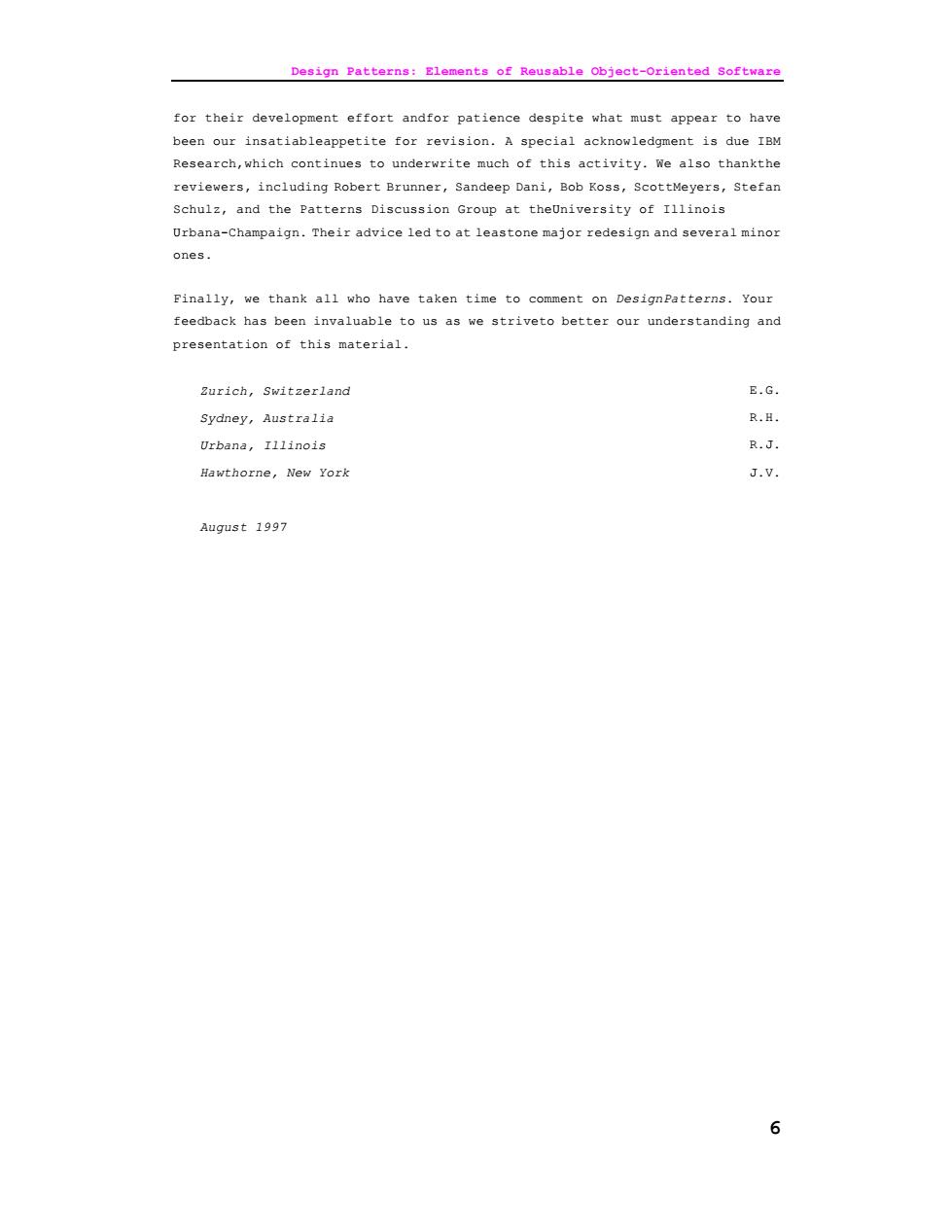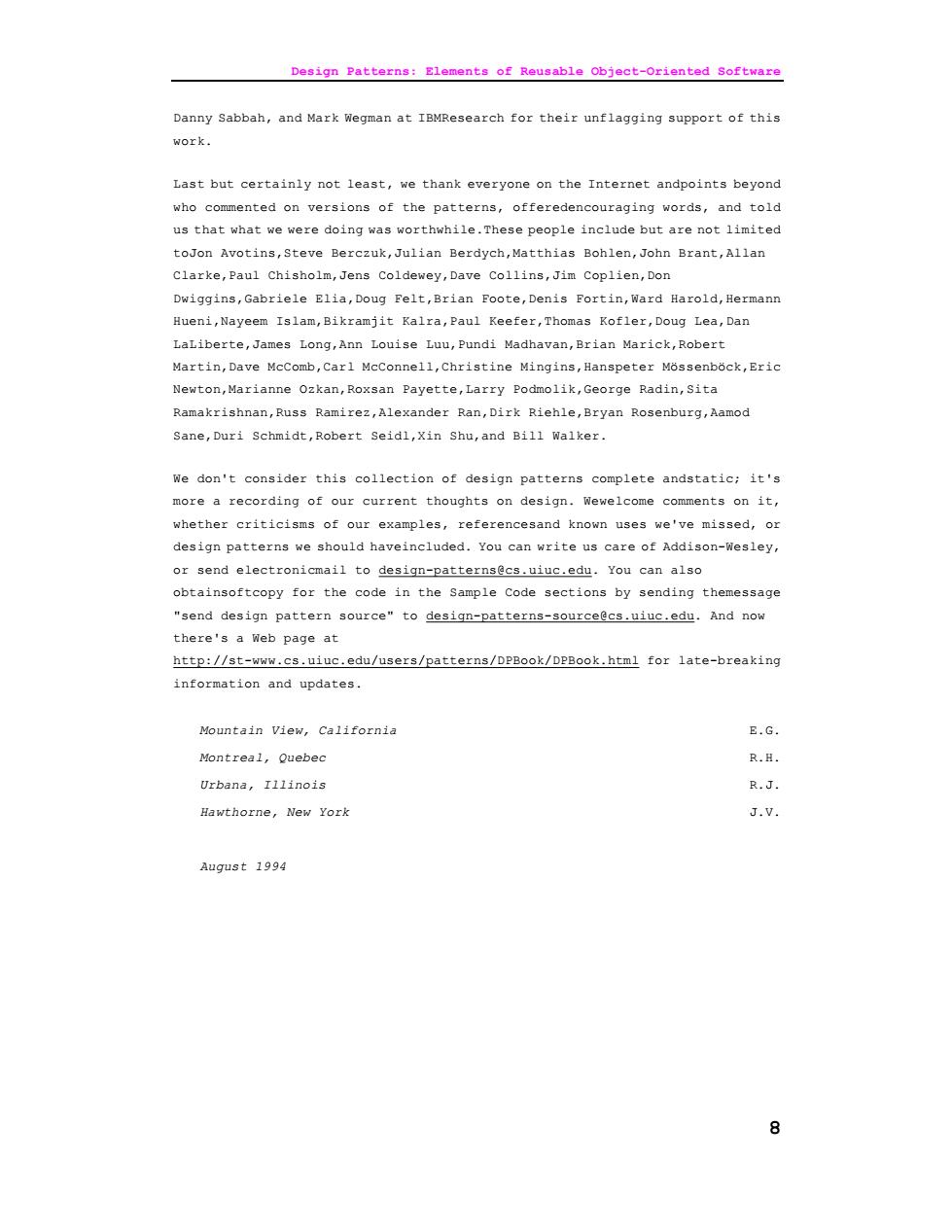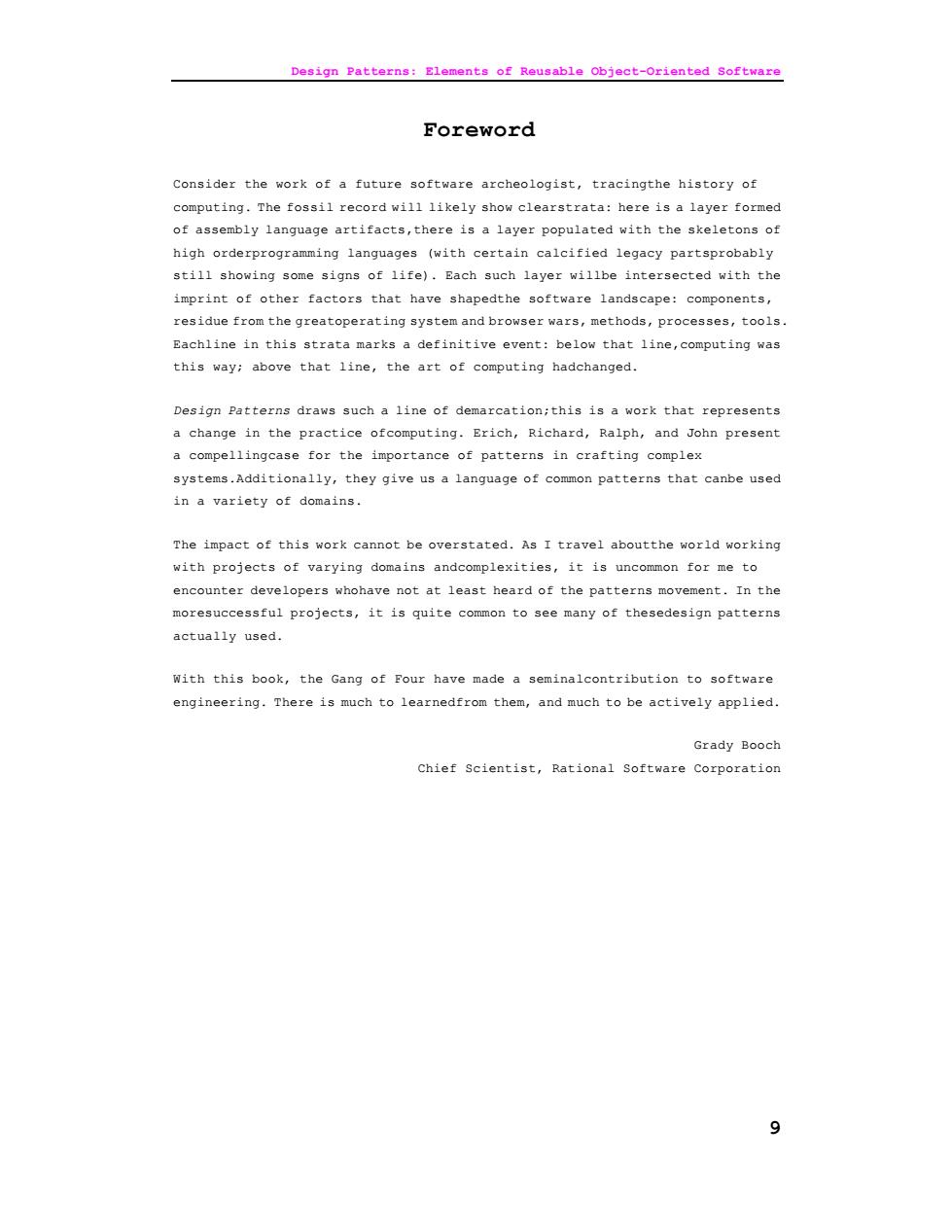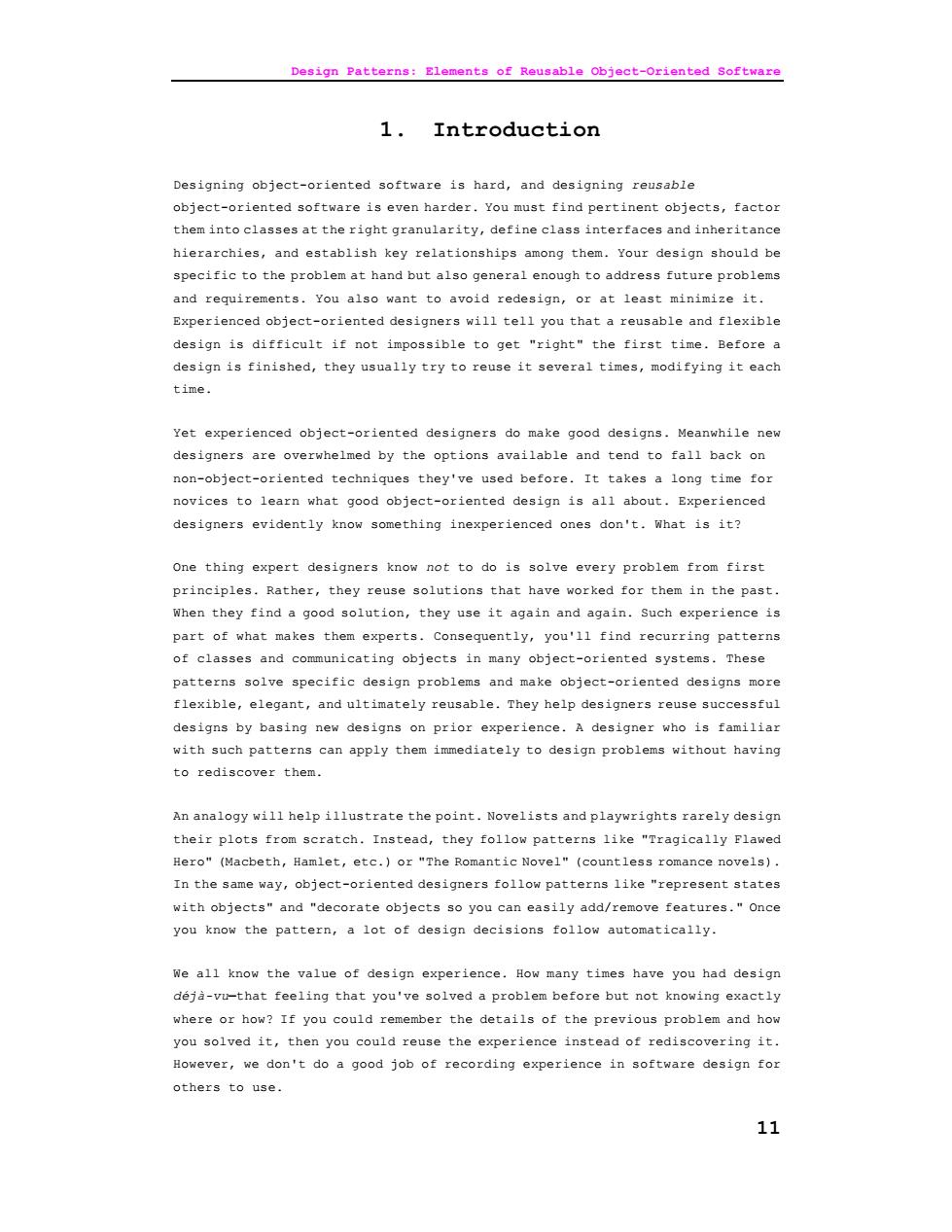
Design Patterns:Elements of Rousable Object-Oriented Software Contents Preface to CD…5 preface to Book........................................................... Guide to Readers..............10 1 Introduct1on..,,..,,,,,..,,,,.,.,.....,.11 1.1 What Is a Design Pattern?.......................................12 1.2 Design Patterns in Smalltalk MvC...... .14 1.3 Describing Design Patterns 16 1.4 The catalog of Deaign Patterns...............................18 1.50 rganiz1 ng the Cata1og.,.......21 1,6 ow Des1 gn Patterns Solve Des.1 gn Problems..,...,·.·.·.·.,·...·.23 1,7 How to Select a Design Pattern,,,,,,,,,.,.,,,,,,,,,,,,,.,,,,,,.42 1.8 How to use a Design Pattern....................44 2 A Case Study:Designing a Document Editor.........................46 2.1De81 gn Problem8,..。.+··。….…。…····。·..。.,。·。.。.。·.…·。·。46 2.2 pocument structure..............................................47 2.3 Formatting… 2.4 Embellishing the User Interte ce …56 2.5 Supporting Multiple Look-and-Feel Standards...........60 2.6 Supporting Multiple Window Systems.............................64 2.70ser0 perations72 2.8 Spelling Checking and Hyphenation..............................77 2.9Summary 90 Design Pattern catalog..............................................93 3 Creational Patterns Factory................................................... 8u1dex.110 Fact0 ry Method,,,,.,。,。,,,。,,,,,,,,,,t,,,,。,,,,,,.,,,。,,,,,,121 Prototype.........................................................133 Singleton...... ......144 Discussion of Creational patterng........................ 153
Design Patterns: Elements of Reusable Object-Oriented Software 2 Contents Preface to CD ........................................................ 5 Preface to Book ...................................................... 7 Foreword ............................................................. 9 Guide to Readers .................................................... 10 1 Introduction ...................................................... 11 1.1 What Is a Design Pattern? ...................................... 12 1.2 Design Patterns in Smalltalk MVC ............................... 14 1.3 Describing Design Patterns ..................................... 16 1.4 The Catalog of Design Patterns ................................. 18 1.5 Organizing the Catalog ......................................... 21 1.6 How Design Patterns Solve Design Problems ...................... 23 1.7 How to Select a Design Pattern ................................. 42 1.8 How to Use a Design Pattern .................................... 44 2 A Case Study: Designing a Document Editor ......................... 46 2.1 Design Problems ................................................ 46 2.2 Document Structure ............................................. 47 2.3 Formatting ..................................................... 53 2.4 Embellishing the User Interface ................................ 56 2.5 Supporting Multiple Look-and-Feel Standards .................... 60 2.6 Supporting Multiple Window Systems ............................. 64 2.7 User Operations ................................................ 72 2.8 Spelling Checking and Hyphenation .............................. 77 2.9 Summary ........................................................ 90 Design Pattern Catalog .............................................. 93 3 Creational Patterns ............................................... 94 Abstract Factory ................................................... 99 Builder ........................................................... 110 Factory Method .................................................... 121 Prototype ......................................................... 133 Singleton ......................................................... 144 Discussion of Creational Patterns .................................. 153

Design Patterns:Elements of Rousable Object-Orientod Software 4 structural patterns 155 ......................................................... Bridge。,。,,,。。。。,171 Comp0site.,....,.,.,..,,.,.,..,.,.,,,.,...。,..,.................183 Facade. 208 eight 218 233 Discussion of structural Patterns.................................246 5 Behavioral Patterna 249 chain of Responsibility........................................... Command.............................................63 Interpreter.......................................................274 t江at0江.289 ..................... 305 16 ObBCEVOE..........................................................326 State。。338 Strategy,,349 Template Method............................................ .360 visitor........ 366 Discussion of Behavioral Patterns................................. 382 6conclugion...................................................... 388 6.1 What to Expect from Design Patterns................... 388 6.2 A Brief Hstoy… 39 6.3 The Pattern community........................................393 6.4 An Invitation.,...,....:.............395 6.5 A Parting Thought...............................................396 aG10aay 397 B Gudde to Notation ................................................ B.1 class Diagram....................................................404 B.2 object Diagram.................................................406 B.3 Interaction Diagram. .....407 c Foundation classes................................409 C.2 Iterator........................................................412 C.3 ListIterator..................................................413
Design Patterns: Elements of Reusable Object-Oriented Software 3 4 Structural Patterns .............................................. 155 Adapter ........................................................... 157 Bridge ............................................................ 171 Composite ......................................................... 183 Decorator ......................................................... 196 Façade ............................................................ 208 Flyweight ......................................................... 218 Proxy ............................................................. 233 Discussion of Structural Patterns ................................. 246 5 Behavioral Patterns .............................................. 249 Chain of Responsibility ........................................... 251 Command ........................................................... 263 Interpreter ....................................................... 274 Iterator .......................................................... 289 Mediator .......................................................... 305 Memento ........................................................... 316 Observer .......................................................... 326 State ............................................................. 338 Strategy .......................................................... 349 Template Method ................................................... 360 Visitor ........................................................... 366 Discussion of Behavioral Patterns ................................. 382 6 Conclusion ....................................................... 388 6.1 What to Expect from Design Patterns ........................... 388 6.2 A Brief History ............................................... 392 6.3 The Pattern Community ......................................... 393 6.4 An Invitation ................................................. 395 6.5 A Parting Thought ............................................. 396 A Glossary ......................................................... 397 B Guide to Notation ................................................ 404 B.1 Class Diagram ................................................. 404 B.2 Object Diagram ................................................ 406 B.3 Interaction Diagram ........................................... 407 C Foundation Classes ............................................... 409 C.1 List .......................................................... 409 C.2 Iterator ...................................................... 412 C.3 ListIterator .................................................. 413

Design Patterns:Elemente of Rousable Object-Orionted Software c.4p01nt..413 C.5 Bect 414 Bibliography..................................................................416
Design Patterns: Elements of Reusable Object-Oriented Software 4 C.4 Point ......................................................... 413 C.5 Rect .......................................................... 414 Bibliography ....................................................... 416

Design Patterns:Elements of Rousable Object-Oriented Software Preface to CD As we were writing Design Patterns,we knew the patterns we weredescribing had value because they had proven themselves in manydifferent contexts.Our hope was that other software engineers wouldbenefit from these patterns as much as we had. Now,three years after its debut,we find ourselves both grateful andthrilled by how the book has been received.Lots of people use it.Many tell us the patterns have helped them desigr and build bettersystems.Many others have been inspired to write their own patterns,and the pool of patterns is growing.And many have commented on whatmight be improved about the book and what they would like to see inthe future. A recurring comment in all the feedback has been how well-suited thebook is to hypertext.There are numerous crosseferences,andchasing referencesis something a computer can do very well.Sincemuch of the software development process takes place on computers,itwould be natural to have a book like ours as an on-line resource.Observations like these got us excited about the potential of thismedium.So when Mike Hendrickson approached us about turning the bookinto a CD-ROM,we jumped at the chance. two years and several egabytes oflater,ve're delighted thatyou can finally obtain this edition,the Design Patterns CD,and put its unique capabilities to work.Now you can access a patternfrom your computer even when someone has borrowed your book.You can search the text for key words and phrases.It's also considerably easier to incorporate parts of it in your own on-line documentation.And if you travel with a notebook computer,you can keep the bookhandy without lugging an extra two pounds of paper Hypertext is a relatively new publishing venue,one we arelearning to use just like everyone else.If you have ideas on howto improve this edition,please send them todesign-patterns-cdecs.uiuc.edu.If you have questions or suggestions concerning the patternsthemselves,send them to thegang-of-4-patternsecs.uluc.edumailing list.(To subscribe,send e-mail to gang-of-4-patterns@cs.uiuc.eduwith the subject"su e".)This list as quite a few readers,and many of them can answer questions as well as we can-andusually a lot faster!Also,be sure to check out thepatterns Home Page athttp://hillside.net/patterna/.There you'll find other books and mailing lista on patterns,notto mention conference information and patterns published on-line. cecand eaon vork ee ison-Wesley for theiron-going encourageme and support.Jeft Helgesen,Jason Jones,andDaniel Savarese garner many thanks 5
Design Patterns: Elements of Reusable Object-Oriented Software 5 Preface to CD As we were writing Design Patterns, we knew the patterns we weredescribing had value because they had proven themselves in manydifferent contexts. Our hope was that other software engineers wouldbenefit from these patterns as much as we had. Now, three years after its debut, we find ourselves both grateful andthrilled by how the book has been received. Lots of people use it.Many tell us the patterns have helped them design and build bettersystems. Many others have been inspired to write their own patterns,and the pool of patterns is growing. And many have commented on whatmight be improved about the book and what they would like to see inthe future. A recurring comment in all the feedback has been how well-suited thebook is to hypertext. There are numerous cross-references, andchasing references is something a computer can do very well. Sincemuch of the software development process takes place on computers, itwould be natural to have a book like ours as an on-line resource.Observations like these got us excited about the potential of thismedium. So when Mike Hendrickson approached us about turning the bookinto a CD-ROM, we jumped at the chance. Two years and several megabytes of e-mail later, we're delighted thatyou can finally obtain this edition, the Design Patterns CD,and put its unique capabilities to work. Now you can access a patternfrom your computer even when someone has borrowed your book. You can search the text for key words and phrases. It's also considerably easier to incorporate parts of it in your own on-line documentation.And if you travel with a notebook computer, you can keep the bookhandy without lugging an extra two pounds of paper. Hypertext is a relatively new publishing venue, one we arelearning to use just like everyone else. If you have ideas on howto improve this edition, please send them todesign-patterns-cd@cs.uiuc.edu.If you have questions or suggestions concerning the patternsthemselves, send them to thegang-of-4-patterns@cs.uiuc.edumailing list. (To subscribe, send e-mail to gang-of-4-patterns@cs.uiuc.eduwith the subject "subscribe".) This list has quite a few readers, and many of them can answer questions as well as we can—andusually a lot faster! Also, be sure to check out thePatterns Home Page athttp://hillside.net/patterns/.There you'll find other books and mailing lists on patterns, notto mention conference information and patterns published on-line. This CD entailed considerable design and implementation work. We areindebted to Mike Hendrickson and the team at Addison-Wesley for theiron-going encouragement and support. Jeff Helgesen, Jason Jones, andDaniel Savarese garner many thanks

Design Patterns:Elemente of Rousable Object-Oriented Software for their development effort andfor patience despite what must appear to have been our insatiableappetite for revision.A special acknowledgment is due I8M Resea h,which contir to underwrite much of this activity. We also thankthe reviewers,including Robert Brunner,Sandeep Dani,Bob Koss,ScottMeyers,Stefan Schulz,and the Patterns Discussion Group at theUniversity of Illinois Urbana-Champaign.Their advice led to at leastone major redesign and several minor one8】 Finally,we thank all who have taken time to comment on DesignPatterns.Your feed nvaluable to us as we striveto better our understanding and presentation of this material Zurich,Switzerland E.G. Sydney,Australia R.H. Urbana,Illinois R.J. Hawthorne,New York J.V. August 1997 6
Design Patterns: Elements of Reusable Object-Oriented Software 6 for their development effort andfor patience despite what must appear to have been our insatiableappetite for revision. A special acknowledgment is due IBM Research,which continues to underwrite much of this activity. We also thankthe reviewers, including Robert Brunner, Sandeep Dani, Bob Koss, ScottMeyers, Stefan Schulz, and the Patterns Discussion Group at theUniversity of Illinois Urbana-Champaign. Their advice led to at leastone major redesign and several minor ones. Finally, we thank all who have taken time to comment on DesignPatterns. Your feedback has been invaluable to us as we striveto better our understanding and presentation of this material. Zurich, Switzerland E.G. Sydney, Australia R.H. Urbana, Illinois R.J. Hawthorne, New York J.V. August 1997

Design Patterns:Elements of Rousable Object-Oriented Software Preface to Book This book isn't an introduction to object-oriented technology or design.Many books already do a good job of that.This book assumes you are reasonably proficient in at least one object-oriented programming language,and you should have some experience in object-oriented design as well.You definitely shouldn't have to rush to the nearest dictionary the moment we mention "types"and "polymorphism, or "interface"as opposed to "implementation"inheritance On the other hand,this isn't an advanced technical treatise either.It's a book of design patterns that describes simple and elegant solutions to specific problems in object-oriented software design.Design patterns capture solutions that have developed and evolved overtime.Hence they aren't the designs people tend to generate initially.They rerlect untold redesign and recoding as developers have struggled for greater reuse and flexibility in their software.Design patterns capture these solutions in a succinct and easily applied form. The design patterns require neither unusual language features nor amazing programming tricks with which to astound your friends and managers.All can be implemented instandard object-oriented languages,though they might take a little nore work the on extra effor iably pays divider in increased flexibility and reusability. Once you understand the design patterns and have had an "Aha!"(and not just a "Huh?")experience with them,you won't ever think about obiect-oriented design in the same way.You'll have insights that can make your own designs more flexible, modular,reusable,and understandable-which is why you're interested in object-oriented technology in the first place,right? A word of warning and encouragement:Don't worry if you don't understand this book completely on the first reading.We didn't understand it all on the first writing!Remember that this isn't a book to read once and put on a shelf.We hope you'11 find yourself referring to it again and again for design insights and for inspiration. This book has had a long gestation.It has seen four countries,three of its authors' marriages,and the birth of two (unrelated)offspring.Many people have had a par in its development.Special thanks are due Bruce Anderson,Kent Beck,and Andre Weinand for their inspiration and advice.We also thank those who reviewed drafta ot the manuscript:Roger Bieleteld,Grady Booch,Tom Carqill,Marshall cline, Ralph Hyre,Brian Kernighan,Thomas Laliberty, nz,Arthur Riel,Doug to the team at Addison-Wesley for their help and patience:Kate Habib,Tiffany Moore,Lisa Raffaele,Pradeepa Siva,and John Wait.Special thanks to Carl Kessler, 7
Design Patterns: Elements of Reusable Object-Oriented Software 7 Preface to Book This book isn't an introduction to object-oriented technology or design. Many books already do a good job of that. This book assumes you are reasonably proficient in at least one object-oriented programming language, and you should have some experience in object-oriented design as well. You definitely shouldn't have to rush to the nearest dictionary the moment we mention "types" and "polymorphism," or "interface" as opposed to "implementation” inheritance. On the other hand, this isn't an advanced technical treatise either. It’s a book of design patterns that describes simple and elegant solutions to specific problems in object-oriented software design. Design patterns capture solutions that have developed and evolved overtime. Hence they aren't the designs people tend to generate initially. They reflect untold redesign and recoding as developers have struggled for greater reuse and flexibility in their software. Design patterns capture these solutions in a succinct and easily applied form. The design patterns require neither unusual language features nor amazing programming tricks with which to astound your friends and managers. All can be implemented in standard object-oriented languages, though they might take a little more work than ad hoc solutions. But the extra effort invariably pays dividends in increased flexibility and reusability. Once you understand the design patterns and have had an "Aha!" (and not just a "Huh?") experience with them, you won't ever think about object-oriented design in the same way. You'll have insights that can make your own designs more flexible, modular, reusable, and understandable—which is why you're interested in object-oriented technology in the first place, right? A word of warning and encouragement: Don't worry if you don’t understand this book completely on the first reading. We didn’t understand it all on the first writing! Remember that this isn't a book to read once and put on a shelf. We hope you'll find yourself referring to it again and again for design insights and for inspiration. This book has had a long gestation. It has seen four countries, three of its authors' marriages, and the birth of two (unrelated) offspring.Many people have had a part in its development. Special thanks are due Bruce Anderson, Kent Beck, and André Weinand for their inspiration and advice. We also thank those who reviewed drafts of the manuscript: Roger Bielefeld, Grady Booch, Tom Cargill, Marshall Cline, Ralph Hyre, Brian Kernighan, Thomas Laliberty, Mark Lorenz, Arthur Riel, Doug Schmidt, Clovis Tondo, Steve Vinoski, andRebecca Wirfs-Brock. We are also grateful to the team at Addison-Wesley for their help and patience: Kate Habib,Tiffany Moore,Lisa Raffaele,Pradeepa Siva, and John Wait.Special thanks to Carl Kessler

Design Patterns:Elemente of Rousable Object-Oriented Software Danny Sabbah,and Mark Wegman at IBMResearch for their untlagging support ot this work. Last but certainly not least,we thank everyone on the Internet andpoints beyond who commented on versions of the patterns,offeredencouraging words,and told us that what we were doing was worthwhile.These people include but are not limited toJon Avotins,Steve Berczuk,Julian Berdych,Matthias Bohlen,John Brant,Allan Clarke,Paul Chisholm,Jens Coldewey,Dave Collins,Jim Coplien,Don Dwiggins,Gabriele Elia,Doug Felt,Brian Foote,Denis Fortin,Ward Harold,Herman Hueni,Nayeemi m,Bikramjit Kalra,Paul Keefer,Th as Kof Lea,Da LaLiberte,James Long,Ann Louise Luu,Pundi Madhavan,Brian Marick,Robert Martin,Dave McComb,Carl McConnell,Christine Mingins,Hanspeter Nossenbock,Eric Newton,Marianne Ozkan,Roxsan Payette,Larry Podmolik,George Radin,Sita Ramakrishnan,Russ Ramirez,Alexander Ran,Dirk Riehle,Bryan Rosenburg,Aamod Sane,Duri Schmidt,Robert Seidl,Xin Shu,and Bill Walker We don't consider this collection of design patterns complete andstatic;it's more a recording of our current thoughts on design.Wewelcome comments on it, whether criticisms of our examples,referencesand known uses we've missed,or design patterns we should haveincluded.You can write us care of Addison-Wesley, o nd eEro to deian-pa iuc.ed Yo ci in th Sampie Code sections by sendin g themessage 'send design pattern source"to design-patterns-sourceecs.uiuc.edu.And now there's a Web page at http://st-www.cs.uiuc.edu/users/patterns/DPBook/DPBook.html for late-breaking information and updates. Mountain View,California E.G. Montreal.Quebec R.且 Urbana,I1linois R.J. Hawthorne,New Yor J.V. August 1994 8
Design Patterns: Elements of Reusable Object-Oriented Software 8 Danny Sabbah, and Mark Wegman at IBMResearch for their unflagging support of this work. Last but certainly not least, we thank everyone on the Internet andpoints beyond who commented on versions of the patterns, offeredencouraging words, and told us that what we were doing was worthwhile.These people include but are not limited toJon Avotins,Steve Berczuk,Julian Berdych,Matthias Bohlen,John Brant,Allan Clarke,Paul Chisholm,Jens Coldewey,Dave Collins,Jim Coplien,Don Dwiggins,Gabriele Elia,Doug Felt,Brian Foote,Denis Fortin,Ward Harold,Hermann Hueni,Nayeem Islam,Bikramjit Kalra,Paul Keefer,Thomas Kofler,Doug Lea,Dan LaLiberte,James Long,Ann Louise Luu,Pundi Madhavan,Brian Marick,Robert Martin,Dave McComb,Carl McConnell,Christine Mingins,Hanspeter Mössenböck,Eric Newton,Marianne Ozkan,Roxsan Payette,Larry Podmolik,George Radin,Sita Ramakrishnan,Russ Ramirez,Alexander Ran,Dirk Riehle,Bryan Rosenburg,Aamod Sane,Duri Schmidt,Robert Seidl,Xin Shu,and Bill Walker. We don't consider this collection of design patterns complete andstatic; it's more a recording of our current thoughts on design. Wewelcome comments on it, whether criticisms of our examples, referencesand known uses we've missed, or design patterns we should haveincluded. You can write us care of Addison-Wesley, or send electronicmail to design-patterns@cs.uiuc.edu. You can also obtainsoftcopy for the code in the Sample Code sections by sending themessage "send design pattern source" to design-patterns-source@cs.uiuc.edu. And now there's a Web page at http://st-www.cs.uiuc.edu/users/patterns/DPBook/DPBook.html for late-breaking information and updates. Mountain View, California E.G. Montreal, Quebec R.H. Urbana, Illinois R.J. Hawthorne, New York J.V. August 1994

Design Patterns:Elements of Rousable Object-Oriented Software Foreword Consider the work of a future software archeologist,tracingthe history of computing.The tossil record will likely show clearstrata:here is a layer formed of assembly language artifacts,there is a layer populated with the skeletons of high orderprogramming languages (with certain calcified legacy partsprobably still showing aome aigns of life).Each auch layer willbe intersected with the imprint of other factors that have shapedthe software landscape:components residue from the greatoperating system and browser wars,methods,processes,toolg Eachline in this strata marks a definitive event:below that line,computing was this way;above that line,the art of computing hadchanged Deaign Patterns draws auch a line of demarcationithis is a work that repr in the practice ofcomputing. Erich,Richard, and John presen a compellingcase for the importance of patterns in crafting complex systems.Additionally,they give us a language of common patterns that canbe used in a variety of domains. The impact of this work cannot be overstated.As I travel aboutthe world working with projects of varying domains andcomplexities,it is uncomon for me to encounter de not at t heard of the e patterns mo In the moresuccessful projects,it is quite common to see many of thesedesign patterns actually used. With this book,the Gang of Four have made a seminalcontribution to software engineering.There is much to learnedfrom them,and much to be actively applied. Grady Booch Chief Scientist,Rational Software Corporation
Design Patterns: Elements of Reusable Object-Oriented Software 9 Foreword Consider the work of a future software archeologist, tracingthe history of computing. The fossil record will likely show clearstrata: here is a layer formed of assembly language artifacts,there is a layer populated with the skeletons of high orderprogramming languages (with certain calcified legacy partsprobably still showing some signs of life). Each such layer willbe intersected with the imprint of other factors that have shapedthe software landscape: components, residue from the greatoperating system and browser wars, methods, processes, tools. Eachline in this strata marks a definitive event: below that line,computing was this way; above that line, the art of computing hadchanged. Design Patterns draws such a line of demarcation;this is a work that represents a change in the practice ofcomputing. Erich, Richard, Ralph, and John present a compellingcase for the importance of patterns in crafting complex systems.Additionally, they give us a language of common patterns that canbe used in a variety of domains. The impact of this work cannot be overstated. As I travel aboutthe world working with projects of varying domains andcomplexities, it is uncommon for me to encounter developers whohave not at least heard of the patterns movement. In the moresuccessful projects, it is quite common to see many of thesedesign patterns actually used. With this book, the Gang of Four have made a seminalcontribution to software engineering. There is much to learnedfrom them, and much to be actively applied. Grady Booch Chief Scientist, Rational Software Corporation

Design Patterns:Elements of Rousable Object-Oriented Software Guide to Readers This book has two main parts.The tirst part (Chapters 1 and 2)desczibes wha design patterns are and how they help you designobject-oriented software.It includes a design case study thatdemonstrates how design patterns apply in practice The second partof the book (Chapters 3,4,and 5)is a catalog of the actual designpatterns. The catalog makes up the majority of the book.Its chapters dividethe design patterns into three types:creational,structural,andbehavioral.You can use the catalog in several ways.You can readthe catalog from start to finish,or you can just browse from patternto pattern.Another approach is to study one of the chapters.Thatwill help you see how closely related patterns distinguish themselves. You can use the references between the patterns as a logicalroute through the catalog.Thi app oach will give you insightinto how patterns relate to each other how they can be combinedwith other patterns,and which patterns work well together Figure 1.1(page 23)depicts these references graphically. Yet another way to read the catalog is to use a more problem-directedapproach. skip to section 1.6 (page 23)to read about some common problems in designing reusable object-orientedsoftware:then read the patterns that address these problems Somepeople read the catalog through first and then use aproblem-directed approach to apply the patterns to their projects. If you aren't an experienced object-oriented designer,then start withthe simplest and most common patterns: Abstract Factory (page 99) Adapter (157 ·Composite(183】 ·Decorator(196) ·Factory Method(121) Obser er1326) ·Strategy(349) Template Method(360 It's hard to find an object-oriented system that doesn't use at leasta couple of these patterns,and large systems use nearly all of them.This subset will help you understand design patterns in particular andgood object-oriented design in general. 10
Design Patterns: Elements of Reusable Object-Oriented Software 10 Guide to Readers This book has two main parts. The first part (Chapters 1 and 2)describes what design patterns are and how they help you designobject-oriented software. It includes a design case study thatdemonstrates how design patterns apply in practice. The second partof the book (Chapters 3, 4, and 5) is a catalog of the actual designpatterns. The catalog makes up the majority of the book. Its chapters dividethe design patterns into three types: creational, structural, andbehavioral. You can use the catalog in several ways. You can readthe catalog from start to finish, or you can just browse from patternto pattern. Another approach is to study one of the chapters. Thatwill help you see how closely related patterns distinguish themselves. You can use the references between the patterns as a logicalroute through the catalog. This approach will give you insightinto how patterns relate to each other, how they can be combinedwith other patterns, and which patterns work well together. Figure 1.1(page 23) depicts these references graphically. Yet another way to read the catalog is to use a more problem-directedapproach. Skip to Section 1.6 (page 23) to read about some common problems in designing reusable object-orientedsoftware; then read the patterns that address these problems. Somepeople read the catalog through first and then use aproblem-directed approach to apply the patterns to their projects. If you aren't an experienced object-oriented designer, then start withthe simplest and most common patterns: · Abstract Factory (page 99) · Adapter (157) · Composite (183) · Decorator (196) · Factory Method (121) · Observer (326) · Strategy (349) · Template Method (360) It's hard to find an object-oriented system that doesn't use at leasta couple of these patterns, and large systems use nearly all of them.This subset will help you understand design patterns in particular andgood object-oriented design in general

Design Patterns:Elements of Rousable Object-Oriented Software 1. Introduction Designing object-oriented software is hard,and designing reusable object-oriented software is even harder.You must find pertinent obiects,factor them into classes at the right granularity,define class interfaces and inheritance hierarchies.and establish key relationships among them.Your design should be specific to the problem at hand but also general enough to address fut and requirements.You also want to avoid redesign,or at least minimize it. Experienced object-oriented designers will tell you that a reusable and flexible design is difficult if not impossible to get "right"the first time.Before a design is finished,they usually try to reuse it several times,modirying it each time Yet experienced obje toriented designers do make good designs. Meanwhile new designers are overwhelmed by the options available and tend to fall back on non-object-oriented techniques they've used before.It takes a long time for novices to learn what good object-oriented design is all about.Experienced designers evidently know something inexperienced ones don't.What is it? One thing expert designers know not to do is solve every problem from first principl her,they reus e solutio that have worke them in the past When they find a good solution,they use it again and again.Such experience is part of what makes them experts.Consequently,you'll find recurring patterns of classes and communicating objects in many object-oriented systems.These patterns solve specific design problems and make object-oriented designs more flexible,elegant and ultimately reusable.They help designers reuse su designs by basing new designs on prior experience.A designer who is familiar with such patterns can apply them immediately to design problems without having to rediscover them. An analogy will help illustrate the point.Novelists and playwrights rarely design their plots from scratch.Instead,they follow patterns like "Tragically Plawed Hamlet,etc. tic Novel" In the same way,object-oriented designers follow patterns like "represent states with objects"and "decorate objects so you can easily add/remove features."Once you know the pattern,a lot of design decisions follow automatically. We all know the value of design experience.How many times have you had design deja-vu-that feeling that you've solved a problem before but not knowing exactly where or how?If you ould emember the details of the previc ous probler and b you solved it,then you could reuse the experience instead of rediscovering it. However,we don't do a good job of recording experience in software design for others to use. 11
Design Patterns: Elements of Reusable Object-Oriented Software 11 1. Introduction Designing object-oriented software is hard, and designing reusable object-oriented software is even harder. You must find pertinent objects, factor them into classes at the right granularity, define class interfaces and inheritance hierarchies, and establish key relationships among them. Your design should be specific to the problem at hand but also general enough to address future problems and requirements. You also want to avoid redesign, or at least minimize it. Experienced object-oriented designers will tell you that a reusable and flexible design is difficult if not impossible to get "right" the first time. Before a design is finished, they usually try to reuse it several times, modifying it each time. Yet experienced object-oriented designers do make good designs. Meanwhile new designers are overwhelmed by the options available and tend to fall back on non-object-oriented techniques they've used before. It takes a long time for novices to learn what good object-oriented design is all about. Experienced designers evidently know something inexperienced ones don't. What is it? One thing expert designers know not to do is solve every problem from first principles. Rather, they reuse solutions that have worked for them in the past. When they find a good solution, they use it again and again. Such experience is part of what makes them experts. Consequently, you'll find recurring patterns of classes and communicating objects in many object-oriented systems. These patterns solve specific design problems and make object-oriented designs more flexible, elegant, and ultimately reusable. They help designers reuse successful designs by basing new designs on prior experience. A designer who is familiar with such patterns can apply them immediately to design problems without having to rediscover them. An analogy will help illustrate the point. Novelists and playwrights rarely design their plots from scratch. Instead, they follow patterns like "Tragically Flawed Hero" (Macbeth, Hamlet, etc.) or "The Romantic Novel" (countless romance novels). In the same way, object-oriented designers follow patterns like "represent states with objects" and "decorate objects so you can easily add/remove features." Once you know the pattern, a lot of design decisions follow automatically. We all know the value of design experience. How many times have you had design déjà-vu—that feeling that you've solved a problem before but not knowing exactly where or how? If you could remember the details of the previous problem and how you solved it, then you could reuse the experience instead of rediscovering it. However, we don't do a good job of recording experience in software design for others to use